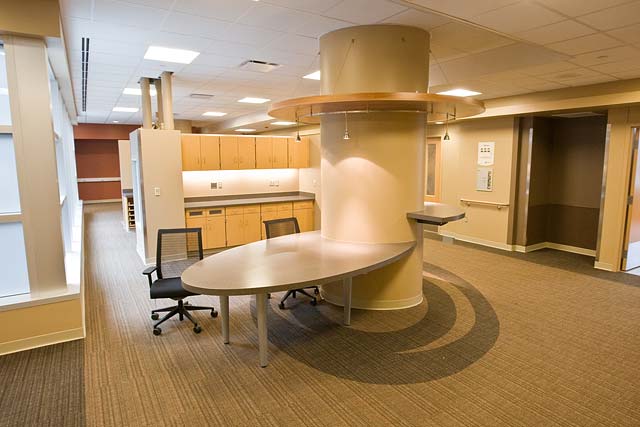
Is there a lack of innovation in healthcare design today?
There are plenty of nice new projects, but, according to many in the industry, not a lot of groundbreaking design ideas. Perhaps innovation is overrated. After all, it took us 100 years to put wheels on our suitcases.
Have we come to a point in healthcare design where innovation is in the execution of tried and true ideas that enhance patient care and staff satisfaction? Maybe.
Innovative Healthcare Design Ideas
Since the very first Symposium on Health Care Interior Design in 1988, we’ve seen many innovative design ideas for hospital projects emerge that now seem like no-brainers. Ten that stand out for me (in no particular order) are:
- Removing the barriers from the nurse station
- Getting rid of semi-private patient rooms
- Making the window in the patient room larger and lowering its height
- Replacing long corridors on patient units with a “pod” concept
- Providing access to positive distractions — art, nature, music, etc.
- Widening the bathroom door in patient rooms
- Creating “family zones” in patient rooms
- Locating the patient room bathroom on the headwall
- Using design elements for intuitive wayfinding
- Placing distributed nurse stations on patient units
Some recent innovative concepts that affect healthcare facility design include the Patient Mobility Platform developed by Roger Leib, a trained architect who’s spent his career designing healthcare furniture. This suite of mobility products includes a “sit-stand” type of device that patients use when not sleeping to move about their rooms and on clinical units.
For the Rehabilitation Institute of Chicago’s new hospital, HDR Architects and Gensler have followed their client’s direction and designed patient floors around AbilityLabs™, which bring medical and research teams to the patient and allow patients to access them from their rooms. Parallel bars are being replaced with anti-gravity harnesses that hang from the ceiling and allow patients to walk around the lab — even up stairs.
Neither of these ideas has been executed in a completed project yet, and isn’t it interesting that they both focus on mobility? Just like the design ideas listed above focused on increasing safety and lowering stress.
Is mobility the next frontier for healthcare design? Or is it something else?
P.S. Please do me a favor — if you liked this post and like this blog, please share it with others by sending them the link and/or post it on your Twitter, LinkedIn, or Facebook, etc. Also, don’t forget to subscribe, so you’ll get emails when new content is posted. Thanks!
If you like this post, please share.

What’s my story? I’m a healthcare and senior living design knowledge expert who writes and speaks frequently about trends and issues affecting these two industries. I’m also a strategic marketing consultant and content creator, working with companies and organizations who want to improve the quality of healthcare and senior living through the design of the physical environment. You can reach me at [email protected].


2 Responses
Sara,
Putting wheels on suitcases got my attention. I recently started putting feet on nursery pots. My innovation hasn’t caught on yet but I’m hopeful. If you take a look at my website (link below) you will see what I’m talking about.
http://www.daylightdesign.net/feetpots1.html
Okay so…, why am I reading about Healthcare Design? My original idea was to design indoor growing systems that were more attractive. I got lucky and ended up with more attractive and more accessible. (link below)
http://www.daylightdesign.net/
With accessibility in mind, I donated equipment to Barklay Friends Continuing Care Community and Bryn Mawr Rehab Hospital in PA and to Iona Senior Services in DC. So far the response has been encouraging.
-John
Great idea, John! Good luck with it.